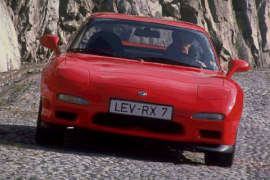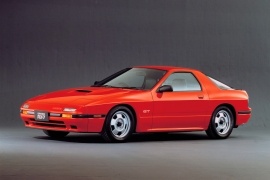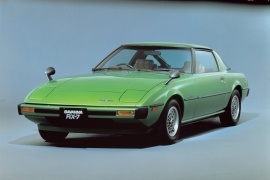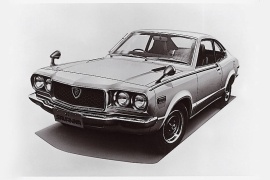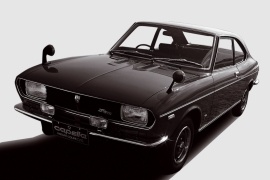MAZDA RX-7 Models/Series Timeline, Specifications & Photos
First production year: 1970
Engines: Gasoline
Body style: Coupé (two-door)
Mazda introduced the third generation of the RX7 in 1992, and it became an iconic Japanese sportscar, even though it was underappreciated when it was launched.
The Japanese automaker was the only car manufacturer in the world that placed its bets on the Wankel-type rotary engine. Moreover, it developed it to create an even more efficient powerplant than before. But it didn't just work on the mill; it also created an unmistakable shape for the Japanese coupe.
Born during the bio-design era, the third generation of the RX7 (also known as the FD) featured organic shapes, rounded corners, and pop-up headlights. The low nose and slim profile of the engine compartment were something that a regular vehicle with an inline engine couldn't have. The small cabin featured just two doors and was ended by a very long and sloped rear windscreen. At the back, Mazda added a wing on the tailgate's end. Finally, the rear fascia sported a wide taillight that stretched from side to side.
Inside, the automaker continued the bio-design trend and created rounded shapes. In addition, the center stack was tilted toward the driver's seat. Mazda installed high-bolstered bucket seats in the car, separated by a tall center console that hosted the gear stick for the standard five-speed manual and a storage compartment. Besides the sound system, the center stack hosted the HVAC controls and a small storage area.
The RX-7 was a purpose-built vehicle. As a result, the carmaker offered the base version with just enough amenities, while the top-spec one featured a sunroof and a four-speed automatic transmission. The 1.3-liter engine featured a unique twin-turbo sequential system that helped it get an almost flat torque curve.
Nicknamed "The Japanese Porsche 924", the second generation of the RX7 came on the market in 1987 and received constant upgrades until the car's retirement in 1995.
Mazda had a long reputation and experience with rotary engines and decided to use it on the second generation of the RX7. It was a similar engine as its predecessor but upgraded with new technologies, which made it more powerful. While the earlier RX7s featured naturally-aspirated units, the later ones were available with a turbocharger, which opened the doors for more ponies, and all were running.
When Akio Uchiyama designed the car, he allegedly was inspired by the Porsche 924. On the other hand, the aerodynamic played its crucial role in the car's shapes, including the pop-up headlights at the front. Uchiyama installed a set of parking lights and the turn signals in the front, wrapped-around plastic bumpers. The flat and short hood has slightly risen before the raked A-pillars. A short roof and a Camaro-Esque rear windscreen completed the greenhouse. In the back, Mazda played it safe with rectangular taillights, flush to the bodywork.
Inside, the carmaker installed two bucket seats at the front and a bench in the rear wide enough for a few letters. The dashboard sported straight lines on it, with a glove-box in front of the passenger and a vertical center stack. Mazda designed an instrument panel wide enough to host two big dials and four gauges.
The RX7 was a sporty coupe for enthusiast drivers. Apart from the rev-happy engine, Mazda installed a complicated rear suspension system built to counter-act the toe-in and toe-out situations during high-speed cornering maneuvers. The twin-rotor Wankel engine sent its power to the rear wheels via a five-speed manual gearbox.
Mazda opened a new chapter in its history when it introduced the first generation of the RX-7 in 1978.
While it was not the first car fitted with a Wankel rotary engine, it was the first car Mazda produced to stir the international sports car market. It was unusual in every way, and the carmaker sold it in high numbers.
Matsaburo Maeda designed the car as a lightweight sport-coupe. He placed the engine behind the front axle, and thus it helped with the weight distribution. Since the engineers pushed the engine back, the front was very narrow and, thanks to its pop-up headlights, very aerodynamic as well. The raked windshield and the short roof were followed by a long and sloped rear window, which was also the trunk lid.
Inside, the carmaker managed to offer four seats, but those in the rear were too small actually to allow someone bigger than a puddle to sit there. At the front, the dashboard was rounded, with circular vents on the outer side and rectangular in the middle. The instrument panel featured a tachometer marked up to 8,000 rpm, with a red-line starting at 7,000 rpm. That was motorcycle territory!
Under the hood, Mazda installed small, 1.2-liter, and 1.5-liter engines with a twin-rotor design. Depending on the engine version, the RX-7 featured a 4- or 5-speed manual. A 3- or 4-speed automatic was offered as an option for the U.S. market.
Mazda started introducing rotary engines since the Japanese regulations less taxed them, and the RX3 was an important step forward in that area.
Mazda offered the RX3 as a replacement for the previous RX2 model. It was available as a coupe, sedan, or station wagon. The Japanese carmaker tried to make the vehicle sporty enough to appeal to the younger generation but comfortable and well equipped for young families.
At the front, it featured dual round headlights and a separate grille between them as the original 1964 ½ Mustang. Even if it was way shorter than the famous pony-car, the RX3 featured a sloped rear window, making the car look even smaller. In the rear, the Japanese designers installed another pair of dual taillights, like some other European carmakers.
Inside, Mazda installed vinyl-covered seats with embossed "pleats" and emblems, but with good finishes. The instrumentation was complete with two main dials in the instrument cluster, and four additional gauges mounted high on the center stack. The Japanese designers placed the radio above the HVAC system, which was a much logical solution. Mazda installed a badge in the middle of the three-spoke steering wheel with the rounded triangular shape of a Wankel rotary engine piston.
The 1.2-liter Wankel engine was designed, so the owner paid smaller taxes, and it offered 90 hp. It was an unusually high specific output. Yet, the fuel-efficiency was worse than most of the similar cars on the market. Its live rear axle with leaf springs was unsuitable for a sporty coupe, but at least it featured power brakes with discs at the front and drums in the rear.
Mazda introduced the Capella in 1970, and besides the inline-four versions, it also made it with a Wankel rotary engine that wore the RX-2 nameplate.
In Japan, vehicles with engines larger than 1.5 liters suffered from tax penalties. So, Mazda came up with the idea of installing a rotary engine under the Capella’s hood. This powerplant was developed by the German engineer Felix Wankel, and instead of using pistons that went up and down into the cylinders, it featured a different system. As a result, the RX-2 could provide the power of a larger engine but still be considered as a 1.3-liter powerplant. Mazda made the RX-2 either as a coupe or a sedan, which helped the automaker increase its sales, especially among young customers.
Both versions of the Capella/RX-2 sported the same front fascia fitted with rectangular or four round headlamps, depending on the market. They flanked a horizontally slatted grille where a vertical chromed trim adorned by a triangular-shaped indent took center stage. That reflected the Wankel’s rotary piston that spun inside the engine. Between the headlights and the chromed metallic bumper, the automaker installed the rectangular lamps of the blinkers. Two additional narrow grilles flanked the bumper above and below it.
The RX-2’s profile revealed a coupe-shaped vehicle sporting a short front end, a panoramic windshield, and a cabin that featured a sloped-down rear window. Even though it looked more like a fastback, the RX-2 Coupe was a two-door sedan. Its four-door sibling had a different rear end, with a more conventional look for the greenhouse. Both versions featured blinkers on the front fenders and chromed flush door handles. A curved line over the rear quarter panels evoked the coke-bottle styling of the American muscle cars of the ‘60s, even though that era was almost gone when the Capella/RX-2 appeared on the market. Finally, at the back, European-inspired twin round taillights mounted on the sides tried to create a sportier look for the vehicle.
Inside, the automaker installed two bucket seats up front and a bench seat in the back. Customers had the option to get the vehicle with cloth or vinyl upholstery. In front of the driver, Mazda installed an instrument cluster with binocular-style dials. On the left was the speedometer, and on the right was the rev counter marked to 9,000 rpm (red-line at 6,500). These flanked three additional gauges mounted inside a round cluster, showing the coolant temperature, the fuel level, and the ammeter. The center console housed the gear stick. Mazda placed the controls for the ventilation system on the center console, while the radio was above it, on the dashboard, next to an analog clock.
Under the hood, the rotary engine was the main difference between the RX-2 and the Capella. According to those times standards, the twin-rotary Wankel unit was considered to have a 1.2-liter displacement. Even though it wasn’t the most powerful engine on the market, it was more potent than many larger engines that suffered from higher taxation.
